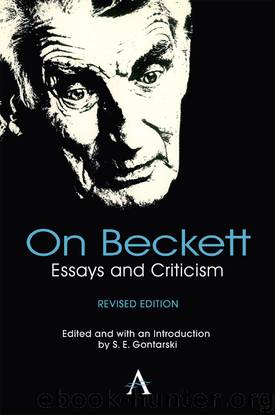On Beckett by Gontarski S. E

Author:Gontarski, S. E. [Gontarski, S. E.]
Language: eng
Format: epub
ISBN: 978 1 78308 154 7
Publisher: Anthem Press
Published: 0101-01-01T00:00:00+00:00
Notes
I gratefully acknowledge the assistance of the Guggenheim Foundation in making my research for this article possible.
1 Samuel Beckett, Ill Seen Ill Said (New York: Grove Press, 1981), paragraph 1. All further references to this work will be included in the text. Ill Seen Ill Said was translated by Beckett from his original French, Mal vu mal dit (Paris, 1981); the first English publication appeared in the New Yorker, 5 October 1981, 48–58. Since the New Yorker edition is important to my argument, I refer to Ill Seen Ill Said by paragraph, or strophe, number rather than by page number.
2 Northrop Frye, The Well-Tempered Critic (Bloomington: Indiana University Press, 1963), 21. All further references to this work, abbreviated Critic, will be included in the text. Northrop Frye, “Verse and Prose,” in Alex Preminger, ed., Princeton Encyclopedia of Poetry and Poetics (Princeton: Princeton University Press, 1974), 885. All further references to this work, abbreviated EPP, will be included in the text.
3 I discuss the question of reference in Beckett’s poetry in The Poetics of Indeterminacy: Rimbaud to Cage (Princeton: Princeton University Press), 200–247.
4 Contemporary prosodists, perhaps because they must account for the difficult case of free verse, generally do equate verse—and hence implicitly the poem—with lineation. For example, Charles O. Hartman, in his recent Free Verse: An Essay on Prosody (Princeton: Princeton Univesity Press, 1980), observes that, difficult as it is to define the word poetry “rigorously and permanently,” verse can be distinguished from prose quite readily: “Verse is language in lines. This distinguishes it from prose.…This is not really a satisfying distinction, as it stands, but it is the only one that works absolutely. The fact that we can tell verse from prose on sight, with very few errors…indicates that the basic perceptual difference must be very simple. Only lineation fits the requirements” (page 11).
But as I have just shown in the case of Beckett and Brodkey, what looks like verse may sound like prose and vice versa. The “basic perceptual difference” between the two is surely not as simple as Hartman suggests. I discuss the question from a somewhat different angle in “The Linear Fallacy,” Georgia Review 35 (Winter 1981): 855–69.
5 See “Lyrics of Fiction” in Ruby Cohn, Back to Beckett (Princeton: Princeton University Press, 1973).
6 Twelve is, of course, a number with multiple symbolic connotations—especially in the New Testament and the book of Revelations. But I think Beckett has in mind especially the twelve signs of the zodiac, whose conjunction symbolizes cosmic wholeness; in this sense, “the twelve” relate to the astrological symbolism of the “zone of stones” (Stonehenge). Nevertheless, “the twelve” are purposely unspecified; their identity is finally as elusive as that of the man in the greatcoat or the stone itself.
7 Samuel Beckett, How It Is (New York: Grove Press, 1964), 138. All further references to this work will be included in the text.
8 For a related discussion of voice in How It Is, see Hugh Kenner, “Shades of Syntax,” in Ruby Cohn, ed., Samuel Beckett: A Collection of Criticism, (New York: McGraw-Hill, 1975), 30–31.
Download
This site does not store any files on its server. We only index and link to content provided by other sites. Please contact the content providers to delete copyright contents if any and email us, we'll remove relevant links or contents immediately.
| African | Asian |
| Australian & Oceanian | Canadian |
| Caribbean & Latin American | European |
| Jewish | Middle Eastern |
| Russian | United States |
4 3 2 1: A Novel by Paul Auster(12264)
The handmaid's tale by Margaret Atwood(7663)
Giovanni's Room by James Baldwin(7164)
Asking the Right Questions: A Guide to Critical Thinking by M. Neil Browne & Stuart M. Keeley(5606)
Big Magic: Creative Living Beyond Fear by Elizabeth Gilbert(5585)
Ego Is the Enemy by Ryan Holiday(5271)
The Body: A Guide for Occupants by Bill Bryson(4955)
On Writing A Memoir of the Craft by Stephen King(4848)
Ken Follett - World without end by Ken Follett(4621)
Adulting by Kelly Williams Brown(4467)
Bluets by Maggie Nelson(4460)
Eat That Frog! by Brian Tracy(4412)
Guilty Pleasures by Laurell K Hamilton(4346)
The Poetry of Pablo Neruda by Pablo Neruda(4021)
Alive: The Story of the Andes Survivors by Piers Paul Read(3956)
White Noise - A Novel by Don DeLillo(3943)
Fingerprints of the Gods by Graham Hancock(3926)
The Book of Joy by Dalai Lama(3884)
The Bookshop by Penelope Fitzgerald(3763)
